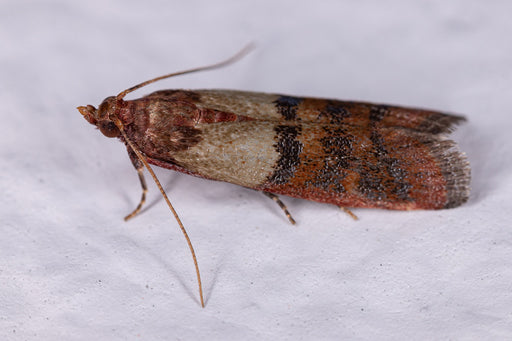How to Get Rid of Pantry Moths in Your Bedroom

Uncovering a Pantry Moth infestation in bedroom closets, drawers, or other dark, quiet spaces is never a pleasant surprise. After all, your bedroom is a sacred place! You’re supposed to be able to relax, unwind, and go to sleep there. You shouldn’t have to spend your nights worrying about creepy crawlies. Plus, finding Pantry Moths in your bedroom can be confusing. These insects are known for hanging around pantries, after all. So why are they in your room, anyway?
This kind of moth problem isn’t entirely uncommon.
You may be surprised to know that finding Pantry Moths in the bedroom is not an entirely uncommon experience. As a matter of fact, apart from pantries, kitchens, and other food storage areas, bedrooms are one of the most common places to find these insects. In this article, we will discuss where Pantry Moths hide, why they are probably in your bedroom, and how to get rid of them for good!
What are Pantry Moths?
Before we go any further, let's discuss what Pantry Moths actually are. That will give you a better idea of how to handle an infestation. Pantry Moths are a type of pestilent insect. Their larvae feed on a range of exposed dry stored goods and often enjoy flour, grain, cereal, sugar, nuts, and many other varieties of shelf-stable items.
A common Pantry type species is the Indian Meal Moth. In general Pantry Moths are small tan, gray, or brown, flying insects. Pantry Moths are one of the most common types of household pests in the United States and Europe. You have probably seen these types of moths flying around before. Pantry Moth infestations can be identified using a few telltale signs. These include silky webs left behind on food, larva in your food items, and casings.
Even though Pantry Moths are most commonly found in pantry and food storage areas, they can easily infest other places as well. They lay eggs anywhere there is peace, quiet, and food can be found. Once a Pantry Moth infestation has spread, it can be hard to stop it without taking serious cleaning, pest control, and sanitation measures. If you have Pantry Moths in your bedroom, there is a good chance that the infestation originated in your pantry and has now started spreading to the rest of your house.
Keep in mind that you may actually be finding Clothes Moths in your bedroom. These moths are very similar in appearance to Pantry Moths and also have hungry larvae. The main difference between Pantry Moths and Clothes Moths is that Pantry Moths feed on dry goods while Clothes Moths feed on clothing items made from animal based fibers.
With that being said, Clothes Moth Larvae are often happy to eat a range of other things as well, and may even munch on non animal based fibers if they are soiled. Whether you are dealing with Clothes Moths or Pantry Moths, eliminating the infestation right away is essential.

Where do Pantry Moths come from?
Pantry Moths come from the outside and infest homes because they lay their eggs in locations where food sources are abundant for their larvae. Sometimes, to get rid of Pantry Moths, you will have to clean your entire pantry and kitchen areas from top to bottom. However, your housekeeping isn't necessarily to blame if you have Pantry Moths in your home.
In many cases, Pantry Moths come into houses by hitching a ride inside dry food packages like unsealed bags of flour. They can build cocoons in cans and jars as well. Sometimes, they will even fly into homes through minuscule gaps in windows, doors, or screens.
However, most Pantry Moths get into houses because they are already in some sort of food item that you purchased at the grocery store. If the bags have been opened or are unsealed you may want to check before bringing them into your house!
How to know if you have a Pantry Moth infestation?
Pantry Moth infestations leave behind plenty of evidence. Nevertheless, it can be hard to know what to look for if you are unfamiliar with this topic. One thing that most people don't realize is that the larvae of the Pantry Moth can chew through exterior food packaging. They can get inside paper boxes, paper bags, plastic wrappers, and more. Here, they weave webs, grow, and feast, before spinning cocoons. This can cause dry goods to clump together, have a strange taste, or simply be filled with larval casings and shells.
You may notice clumps in your flour or bits of cereal that are stuck together for no apparent reason. This is because of the webbing that Pantry Moths leave behind in the pupa stage. Pantry Moth eggs sometimes have an unpleasant taste and odor as well and can be concealed using sticky webbing on the insides of food packages. Infested food items may taste oddly nutty or stale.
Pantry Moth Larvae also like to crawl into tight holes and crevices. You may notice dusty webs in the cracks or creases around your cupboards, near electric light switches, and in other small dark gaps. You might even find little brown moths flying around inside your home. This is because even though these moths are generally pantry dwellers, they are happy to breed and find shelter throughout the rest of your house.
Finally, one of the biggest signs of Pantry Moths is their actual worm-like larvae. These small, shiny caterpillars are usually brown in color. They are easiest to spot when wet. For instance, you may not see any dead or living Pantry Moth Larvae in your dry goods until you do something like get the flour wet. Since these bugs can get coated in dust and flour, they blend in. However, when they are wet, their casings shine and are then easier to see.

Signs of Pantry Moths in the Home May Include:
- Holes in packaging chewed by larvae
- Dead or living brown worm-like larvae
- Webbing left behind from moths
- Adult moths flying in the home
- Strange stale or nutty flavors to food items
- Eggs in webbing or cocoons
Signs of Pantry Moths are more common in items that have expired. This is because these items have been sitting on the shelves for a longer amount of time, giving moths more opportunities to lay eggs and breed. So, avoid eating items past the expiration date and always check your baking flour for signs of Pantry Moths before you start making cookies. After all, you don’t want moth larvae in your cookie dough!
How to Get Rid of Pantry Moths in the Bedroom
Not only are Pantry Moths a pest, but they can infest areas all throughout your home. In fact, sometimes, they even migrate into bedrooms. Are you tired of finding Pantry Moths in your room? If so, here’s what to do.
Okay, so I have Pantry Moths in my bedroom, now what?
You’re probably asking yourself, “what's the first thing to do if I find Pantry Moth Larvae in bedroom spaces?” Well, first and foremost, you will need to identify the source of your infestation. Then, get rid of it!
Generally, Pantry Moths like pantries, hence the name. Therefore, if there are Pantry Moths in your bedroom, it is likely because they have migrated there. Still, it may also be that they are attracted to some sort of edible substance. If you have lots of food in your room, or have been snacking in there resulting in crumbs lying around, that could be the root issue. It all depends. Regardless of the reason for the Pantry Moths in your bedroom, the first thing you need to do is clean thoroughly.
So, start tossing out any dry food items first. Meaning, if you have granola bars, snack items, chips, or other food stored in your bedroom, it's time to say goodbye. Make sure to use a vacuum cleaner and get in all of the cracks and crevices to remove hidden eggs. Remember, these eggs are often stuck on surfaces in hidden spots using sticky webbing.
As such, the vacuum won’t always fix everything. Be sure to spray everything down with a solution of vinegar and water and then wipe away any debris thoroughly. Sometimes, moth webbing can be mistaken for cobwebs. Wipe up anything that looks like a cobweb, spider's web, or a dusty clump.
Position Pantry Moth Traps which will attract the active male moths and help break the breeding cycle. This will enable you to monitor for any further moth presence.
Our 10 steps on How to Get Rid of Pantry Moths gives you lots of information too.

Why do I keep getting moths in the bedroom at night?
Small moths in bedroom drawers, closets, or storage receptacles may be nocturnal, meaning they become more active at night. These types of moths could be Clothes Moths and that is worth checking out before putting away your cashmeres and woolen sweaters! Moths that are attracted to your lights at night tend to be the non pestilent types and will fly in due to the light produced by a television, or other electronics.
If the types of moths in your bedroom are Pantry Moths, you will notice that they fly in a zigzag pattern. Pantry Moths are more active at night as well. Be sure to identify the type of moth in your bedroom and then take steps to remove it based on what you uncover. If it is a Pantry Moth, you may need to deal with an infestation. If it is a larger moth like a Miller, chances are it is in your room because it is attracted to a light source.
Moths in the bedroom can be a serious problem. Few things are worse than having creepy, crawly, flying insects invade your personal space. Plus, no one wants moth larvae eating their fancy silk sheets or expensive clothes. Are moths harmful? No, not to people. However, they will definitely harm your expensive fabrics like leather, wool, silk, and cashmere.
How To Get Rid Of Clothes Moths In Bedrooms
So what can you do? Well, the good news is, lots of things. There are many ways to keep moths out of your bedroom. If you already have an infestation, treating it isn’t terribly difficult. The key is to be thorough and diligent.
The first step will be to place Clothes Moth Traps in locations where you suspect moths may be present. These will attract the active male Clothes and Carpet Moths with a powerful blend of female pheromones on their sticky strips. By catching the male moths you will be able to gauge the size of your moth problem and you will be helping to break the breeding cycle at the same time.
Once you have figured out the likely source of an infestation, it’s time to treat the problem.
What Are Moths Attracted To? Do Moths Eat Clothes?
The moths that tend to infest bedrooms are known as Clothes Moths, or Common Webbing Clothes Moths. Adult moths don't eat clothes, but their larvae do. Webbing Moth Larvae emerge from the eggs and eat through natural fabrics. They can damage clothes, carpets, blankets, and all kinds of home textiles. Things like wool, cashmere, leather, silk, and fur are particularly tasty to moth larvae.
How To Keep Moths Out Of Your Bedroom?
Prevention is key. Make sure you have screens on your windows, only put clean clothes in your closets, vacuum regularly, and consider hanging clothes moth traps. If you already have Clothes Moths in your room, you will need to eliminate the infestation at its source. To keep Pantry Moths out, avoid storing food in your bedroom and use Clothes Moth Traps to keep clothes moths under control.
Where Do Moths Live In The Bedroom?
Moths like dim, secluded places. If you notice moths flying around your closet area, that is the most likely location of an infestation. You can also identify an infestation by the presence of dead moths, larval casings, and holes in garments. A few common bedroom locations where moths are likely to hide include master closets, bins stored under the bed, clothing chests, or other dark, undisturbed places where natural fabrics are stored.
Where Are The Grain Moths Hiding In My Bedroom?
There's a big difference between Clothes Moths vs Pantry Moths. Clothes Moth Larvae eat natural fibers. Pantry Moth Larvae eat dry goods like grains, cereals, flour, pet food, and other exposed dry food stuff. If you have unsealed food stored in your bedroom, that will be where the grain moths are.
Can Moths Live In Carpets?
Yes, especially if your carpets have natural fibers or glues and aren't mothproof. After moth extermination treatment is complete, vacuum all carpeted areas thoroughly, including inside of your closet and under your bed. Move your furniture as well so you can vacuum under and behind it. If you have wood or laminate flooring, you can sweep and mop. Then, hang up Clothes/Carpet Moth Traps in order to catch the active male moths and stop further breeding. In some parts of the world mothballs are still available but are to be avoided as are a toxic method of eliminating moths, larvae and eggs. Herbal repellents like lavender are also a natural option, but aren't as effective and don't last as long as moth traps.
Moths in Bedroom Spaces: FAQs
Now, let's go over a few frequently asked questions concerning Pantry Moths in bedroom spaces.
Do Pantry Moths go into bedrooms?
Yes, Pantry Moths will infest bedrooms if there are food sources for them to eat. Usually, Pantry Moth infestations begin in kitchen cupboards or pantries and then spread to the rest of the home. However, if you have lots of food items stored in your bedroom, the original infestation source may actually be in there.
Why is there a moth in my bedroom?
When you are trying to figure out how to get rid of moths in bedroom spaces, first, you will need to identify what type of moth you have on your hands. Different kinds of moths come into bedrooms for various reasons. If you notice moths in bedroom spaces like cupboards, drawers, or closets, you may be dealing with Clothes Moths. If you notice moths in your nightstand snack drawer, you could have a Pantry Moth infestation. If a moth is trying to fly toward a light, it may have simply entered your bedroom by mistake in search of a way back outside.
Where do moths hide in bedroom areas?

Most invasive moth species like dark, quiet areas where there are plenty of things that they can eat. Moths lay eggs in places where their larvae will be able to feast on animal based fabrics or dry food goods after hatching. This means that they like drawers, crevices, cracks, storage bins, armoires, spots behind furniture, pet food sacks and open containers, and anywhere else that is quiet, convenient, and well-stocked with things to eat.
About MothPrevention
MothPrevention® speak to customers every day about their clothes moth issues - clothes moths are a species that are ever increasing and that can cause significant damage to clothes, carpets and other home textiles.
To date, we’ve helped over 250,000 customers deal with their moth problems. We have developed professional grade solutions including proprietary pheromones and trap design, not available from anybody else in the USA.





